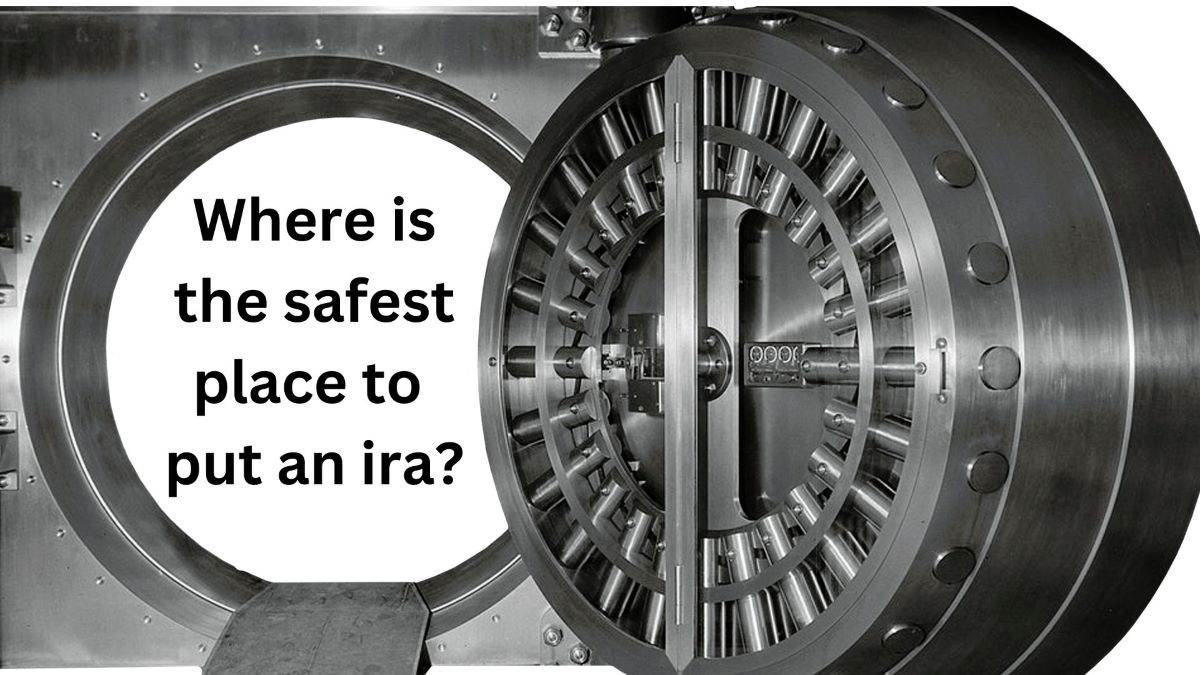Key takeaway:
Related Post:
How to sell gold coins on ebay
What gold ira company does Sean Hannity recommend?
-
- Consider the different options for safely investing an IRA: Understand the pros and cons of each option to make an informed decision about where to put your IRA.
-
- Diversification and allocation are crucial: Spreading your investments across different assets and sectors can help mitigate risk and maximize potential returns.
- Consult with a financial professional: Seeking guidance from a qualified professional can provide personalized advice and ensure that your IRA is placed in the safest and most suitable location.
For investors, the introduction to the safest place to put an IRA is essential. When deciding the most secure option, multiple factors must be taken into account: market volatility, government regulations, and financial stability. Examining these factors carefully helps investors find the best place for their IRA funds and ensure their financial future.
When weighing up IRA options, stability of investments and potential for growth should be a priority. Government regulations and oversight are key, too. It is important to understand how these regulations protect investors and their funds.
The financial stability of the investment vehicle is another consideration. Assessing the organization’s track record, financial statements, and industry reputation is vital. A financially stable institution is more likely to safeguard investor funds and create a secure environment for the IRA.
By examining market volatility, government regulations, and financial stability, investors can make a wise decision on the safest place to put an IRA. Prioritizing security without sacrificing growth allows individuals to shield their retirement savings and secure a solid financial future.
The Different Options for Safely Investing an IRA
When it comes to investing an IRA, there are various options available that prioritize safety. In this section, we will explore the different alternatives and delve into the pros and cons of each option. So, whether you’re considering bonds, certificates of deposit, or another secure investment, we’ll provide valuable insights to help you make an informed decision for your IRA.
Pros and Cons of Each Option
Investing an IRA involves multiple options – each with its own advantages and disadvantages. To make an informed decision, it’s essential to understand the pros and cons of each.
A simple way to compare them is to organize them into a table. This allows for a clear and concise comparison, making it easier to weigh the different factors. Here’s a table highlighting some key aspects to consider when choosing among IRA investment options:
| Option | Pros | Cons |
|---|---|---|
| Stocks | Potential for high returns | Volatile and subject to market fluctuations |
| Bonds | Relatively stable and consistent returns | Lower potential for growth compared to stocks |
| Mutual Funds | Diversification across multiple securities | Management fees can eat into profits |
| Real Estate | Tangible asset that can appreciate over time | Illiquid investment that may require significant initial capital |
| CD’s & Money Market Accounts | Low risk and guaranteed returns | Low interest rates may not keep up with inflation |
More than the table, other factors should be taken into account. These include:
- Risk tolerance
- Investment goals
- Time horizon
- Financial situation
It’s wise to consult a financial professional for personalized advice. They can help assess individual circumstances and guide you towards the safest place for your IRA funds.
Pro Tip: Research and understand the risks of each option before investing. Regularly review and reassess your portfolio to make sure it meets changing goals and needs.
Factors to Consider in Choosing the Safest Place for an IRA
When it comes to choosing the safest place for an IRA, there are several factors to consider. Such as:
- Financial stability and reputation of the institution
- Investment options within the IRA
- Fees and charges associated with the IRA
Customer service and access to manage the IRA are also key points to consider. A thorough assessment of these factors can help individuals make informed decisions and secure their retirement savings.
IRAs were established back in 1974 through the Employee Retirement Income Security Act to provide individuals an extra saving option for retirement. Since then, IRAs have gained popularity, with various types like traditional, Roth, and SEP IRAs being introduced. Knowing the history of IRAs can give individuals a better perspective on retirement saving options and help out their decision-making.
Diversification and Allocation
Diversification and allocation are vital tactics for managing an IRA. By spreading investments across different asset classes and sectors, investors can reduce risk and maybe even gain more returns. Choosing assets based on personal objectives and risk tolerance is also essential to having a well-diversified portfolio. This approach allows investors to take advantage of market opportunities while keeping the effect of any single investment low.
For effectively diversifying and allocating an IRA, think about the following:
- Include a combination of stocks, bonds, and other asset classes to spread danger.
- Choose assets depending on your investment goals and time frame.
- Diversify within asset classes by investing in varied industries.
- Regularly rebalance your portfolio to keep your desired asset allocation.
- Assess and modify your allocation scheme as your financial situation and goals change.
- Consider getting professional advice to help form a suitable diversification and allocation plan.
It is also essential to understand that diversification and allocation are more than just picking various investments. It involves careful research and considering the particular goals and risk tolerance of each investor. By including individual preferences into the decision-making process, a customized approach can be set up, leading to a better strategy in reaching long-term financial objectives.
As investors tackle the complexities of diversification and allocation, it is important to recall that there is no one-size-fits-all approach. Every person’s situation is special, and factors such as age, income, and risk tolerance should be taken into account. By taking the time to inspect these factors and create a well-diversified portfolio, investors can position themselves for long-term success.
With the help of diversification and strategic allocation, many investors have accomplished their financial goals. One example is of a young investor who began with a conservative allocation and gradually increased their exposure to riskier assets over time. By regularly rebalancing their portfolio and being consistent during market turbulence, they were able to collect considerable wealth and retire early. This real-life story illustrates the importance of sticking to a diversified and well-balanced plan, ultimately leading to financial success.
To sum up, diversification and allocation are integral parts of managing an IRA. By spreading investments across different asset classes and sectors, investors can mitigate risk and maybe even get better returns. Also, including individual goals and risk tolerance in the decision-making process can lead to a tailored approach that fits each investor’s unique circumstances. With careful planning and periodic adjustments, investors can position themselves for long-term success and achieve their financial goals.
Consult with a Financial Professional
Consulting a financial pro is vital for making sound investment decisions. They possess the knowledge and expertise to guide you to the best approach for securing your retirement funds. They’ll measure your financial ambitions, risk tolerance, and investment timeline to suggest suitable IRA options.
When consulting a financial pro, they’ll factor in the ideas in “Where Is the Safest Place to Put an IRA?”, like tax matters, investment diversification, and potential returns. They can explain different investment vehicles such as stocks, bonds, mutual funds, and annuities, and how each option fits your financial ambitions.
Further, a financial pro can explain tax-efficient investment plans, like Roth versus Traditional IRA contributions, conversion strategies, and required minimum distributions (RMDs) to optimize your tax planning throughout retirement.
It’s key to note that consulting a financial pro is more than just selecting a secure place for your IRA. They can also update your investment strategy regularly, making sure it follows your changing financial ambitions and the current market conditions. With their expertise, you can stay up to date on market trends, economic indicators, and potential risks, that way you can make educated decisions and adjust your IRA investments accordingly.
When considering the advice of a financial pro, it’s essential to understand why they’re suggesting certain things. For instance, they could recommend diversifying your IRA investments across various asset classes, and note the benefits of spreading risk and potentially achieving more stable long-term returns. They can also explain the advantages of investing in low-cost index funds or target-date funds, which aim to provide broad market exposure while keeping a balanced risk profile.
Conclusion
Some Facts About Where Is the Safest Place to Put an IRA?
- ✅ There are safe places to invest retirement savings to protect them from stock market setbacks, such as cash equivalents, gold, and low-cost mix of stocks and bonds. (Source: Money CNN)
- ✅ Cash equivalents provide security but yield very low returns, making it difficult to build a sufficient nest egg for retirement. (Source: Money CNN)
- ✅ Gold can hold up well during stock market troubles, but it is still volatile and can experience steep losses. (Source: Money CNN)
- ✅ Moving retirement savings to alternatives may shield from market downturns but leaves one vulnerable to other risks. (Source: Money CNN)
- ✅ Completing a risk tolerance-asset allocation questionnaire can help determine the suitable blend of stocks and bonds. (Source: Money CNN)
FAQs about Where Is The Safest Place To Put An Ira?
Where is the safest place to put an IRA for long-term returns?
The safest place to put an IRA for long-term returns is in a low-cost mix of stocks and bonds. This strategy provides a balance between short-term security and potential growth over time.
What are the benefits of investing in Treasury securities in an IRA?
Investing in Treasury securities offers the benefit of guaranteed interest earnings and predictable income streams. These low-risk options provide safety and stability for your retirement savings.
How should I deal with periodic losses in my retirement accounts?
Periodic losses are a normal part of investing. To manage this, it is recommended to maintain a diversified portfolio that includes a mix of stocks and bonds. This can help mitigate short-term downdrafts and allow you to participate in market recoveries.
What are the growth potential and predictable income streams I can expect from low-risk investments?
Low-risk investments, such as fixed annuities and savings accounts, offer reduced risk but also have lower growth potential compared to stocks and mutual funds. However, they provide predictable income streams and guaranteed growth for your retirement savings.
Why should I consider cash equivalents in my IRA portfolio?
It is advisable to keep a portion of your IRA portfolio in cash equivalents for emergencies and spending reserves. However, the majority of your retirement money should be invested for long-term gains to achieve financial goals and combat anemic returns.
How can a retirement income calculator help in determining the suitability of an investment strategy?
A retirement income calculator can help assess the effectiveness of an investment strategy by estimating its performance during market meltdowns, such as severe bear markets. This information provides insight into how the strategy may protect your retirement savings and keep you on track towards a secure retirement.





